Vasaloppet: The race of a lifetime
The Long Road Home for a Swedish American
-
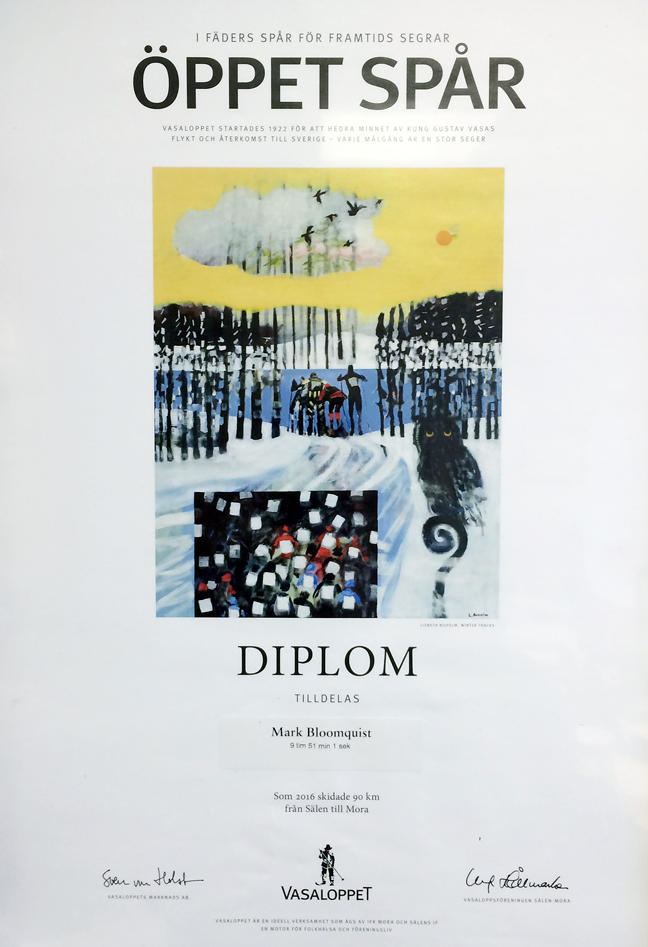
-
-
Every Swede who has completed the 90 kilometer Vasaloppet cross-country ski race from Sälen to Mora receives a certificate with his or her name on it to commemorate the effort. And every one of these Swedes knows where he or she keeps that certificate and will gladly retrieve it and display it to you in less than two minutes.
Now I, too, have such a certificate, I know where it is, and I am gladly displaying it to anyone who shows the slightest bit of interest. And I have an appreciation for why every Vasaloppet finisher wants to share the experience: It is not simply an individual accomplishment, it is part of a shared experience that can be accomplished only with collective effort.
I certainly had enormous help and support to reach the end of Vasaloppet trail. The whole festival spans eight days and requires planning far in advance, paid staff and literally thousands of volunteers. There are races nearly every day, ranging from 9 to 90 kilometers. The course requires constant grooming, volunteers at aid stations and officials for every race. -
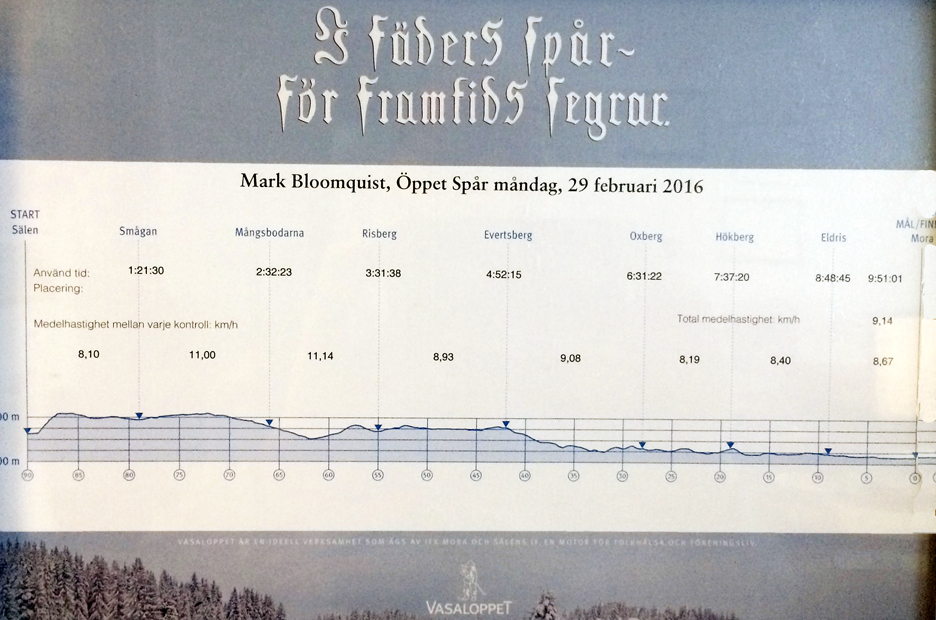
-
-
Preparing for the race of a lifetime
As an individual, my first assistance came from my friend Paul Thompson, who in 2006 convinced me to take part in a ski marathons. He is a member of the Birch Legging Club, a select group of dedicated skiers who have completed 20 or more ski marathons in the American Birkebeiner. The American Birkebeiner spans 50-55 kilometers from Cable to Hayward, Wisconsin, and is the largest (most participants) citizen ski race in North America. With Paul’s encouragement and companionship during many days of training I was able to complete that race, using the skate style technique.
I don’t know exactly when, but at some time after completing my first American Birkebeiner I learned of a yet longer and larger race. Indeed, that was Vasaloppet, the longest and most highly attended citizen ski race in the world. Not only would skiing it be an accomplishment, but it would give me another excuse to travel to Sweden and visit relatives. But it also meant switching from skate style to classic cross-country skiing, the only style permitted at Vasaloppet.
I had to learn a new technique of skiing as well as how to apply grip (kick) wax to the skis. I was lucky to have the help of the experts at Hoiggards Ski Shop in Saint Louis Park, Minnesota; and in particular, ski coach and head service tech David Lindberg developed an effective waxing strategy. For technique I turned to the ski club at The City of Lakes Loppet in Minneapolis — under the tutelage of elite skiers Kate Ellis and Devin Arenz, I learned a number of essential skills, including double poling, double pole kick, quick step uphill striding, weight shift striding and downhill tuck. These skills would allow me to ski efficiently and prevent me from wasting energy, which one cannot do and expect to complete a 90 kilometer course. Also helpful were fellow Minnesotan skiers, including two who stay with relatives in Mora, Sweden and ski Vasaloppet every year and a couple others who have made the pilgrimage for the annual Vasaloppet.
More assistance came from my ski companion, Christer Carlsson of Hindås, which is just east of Göteborg (Gothenburg). Christer is sambo with my syssling (second cousin) Rose-Marie Möller, originally from Lindome, Sweden, birthplace of my mormorfar who immigrated to the USA.
After I had been unsuccessful in my attempt to complete Vasaloppet 2015 for not meeting the cutoff time at 62K (i.e., skiing too slowly), Christer said he would join me in 2016 if I signed up. We agreed, signed up and set a date to rendezvous in Sälen in February 2016, prepared to ski eastbound to Mora. He, in Hindås, and I, in Minnesota, trained in our respective ski areas, sharing our progress by email. -
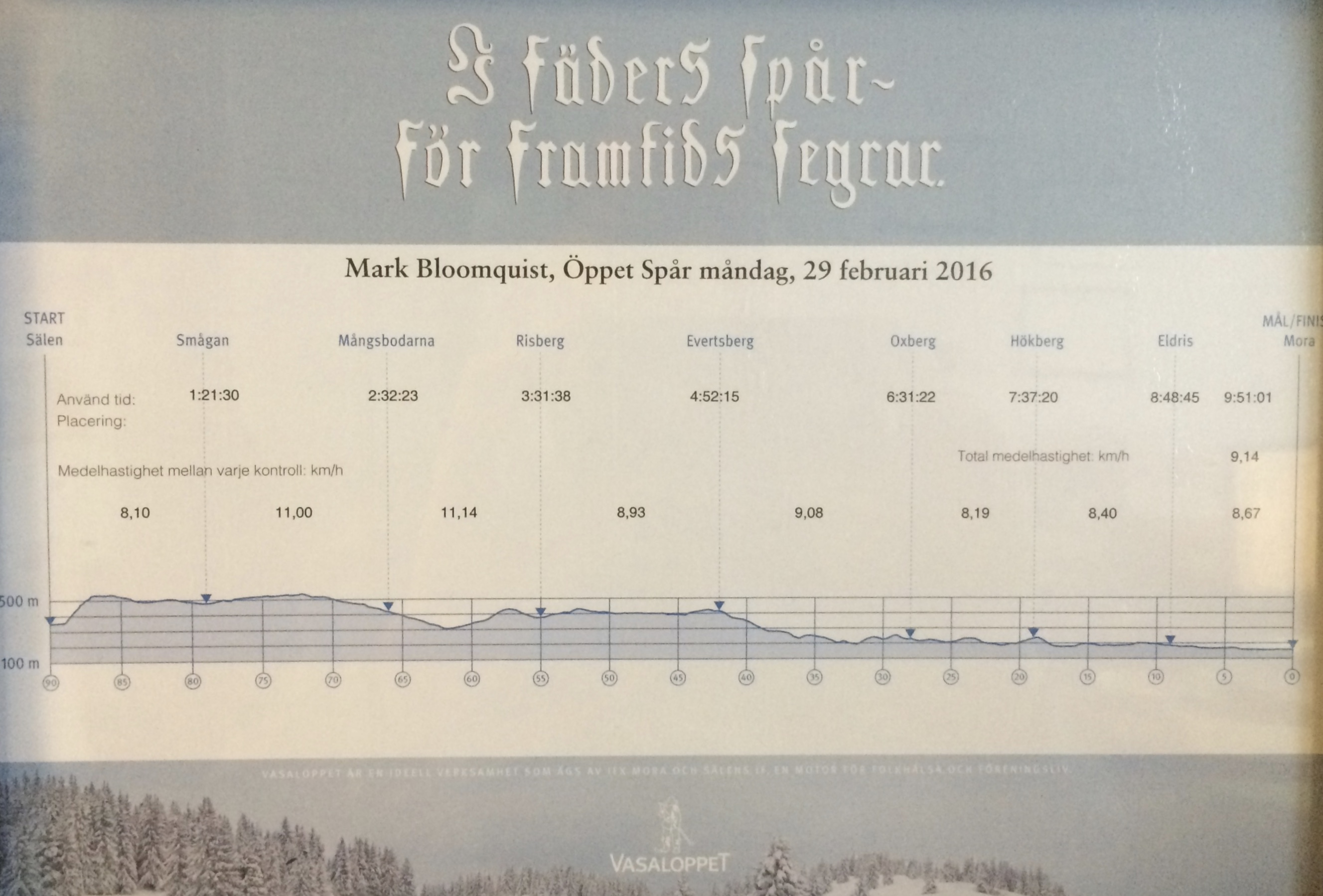 Authentic documentation that one has completed the Vasaloppet — a certificate that embodies the appreciation of a people: “Varje målgång är en stor sever" — Each finish is a great victory.
Authentic documentation that one has completed the Vasaloppet — a certificate that embodies the appreciation of a people: “Varje målgång är en stor sever" — Each finish is a great victory. -
The greatest victory
I flew from Minneapolis to Göteborg and was fortunate to have my daughter, Dana, join me from her home in Copenhagen and accompany me to Mora, acting as a one-person support crew. Dana cooked high-carb food before the race, escorted my group at 4 a.m. to the buses departing for Sälen, and took our warm clothes and boots that would be needed immediately at the end of the race ... assuming we could make it all the way back to Mora.
It would be nearly 14 hours before I arrived at the finish in Mora. It was a memorable day for of us and the details could fill another article. But it is the support from others that will remain in my memory. From the bus driver hurtling us through the dark, to the volunteers at the start managing our gear to carry it to the finish line, to the women leading us in warm up calisthenics from platforms above the throng of skiers, everyone was pulling in the same direction. Then the starting cannon sounded and the sea of humanity moved eastward, all drawing on each other’s energy.
The support continued throughout the race. The first three kilometers are up an unreasonably long and steep hill. Everyone knows it is brutal yet no one complains. The primary goal is to stay out of each other’s way and don’t break anyone else’s pole. It's the epitome of human decency in the face of adversity, and Christer and I (and most of the group) summited the first hill with our poles intact. Hoorah!
From there onward it was a true endurance test which would have been impossible but for the volunteers at the rest stops in each of the seven towns on the trail from Sälen to Mora. Though my race was on a Monday, literally hundreds of people turned out to supply what seemed like the nectar of the Gods to weary travelers: blåbär soppa, enerji, vatten, kafé och bulle (blueberry soup, Gatorade, water, coffee and rolls).
One of my best memories of the day was the beauty of the countryside we traversed. Tall evergreens interrupted the low sunlight and cast long shadows across the trail. Then it would open up to broad fields and lakes where the sunlight seemed to explode. We even went through a semi-mountainous area below a downhill ski run which reminded me of Colorado and Montana.
We skied the final 9K stretch through the lightly forested area from Eldris to Mora. Though it was after 5 p.m. when I emerged onto the 600 meter homestretch to the mål (finish line), the local faithful were there to cheer me on. It was heartwarming to hear over the PA, “And now comes Mark Bloomquist from United States. Welcome to Mora.” (Later, my daughter told me the announcer had continued in Swedish: “Bloomquist? Han är inte American. Jag tror att han måste vara svenska.”("Bloomquist? He is not American. I believe he must be Swedish.") Ever faithful, Dana was there with my comfortable shoes which never felt so good as they did after that 90K ordeal. We eventually reunited with Christer, who had finished 45 minutes ahead of me. (He attributed his stronger performance to all the rolls and coffee he consumed earlier, though I knew better.)
We both had quite a lot to be thankful for. Perhaps most gratifying was to share our accomplishment with our hosts in Mora, Majbritt and Stefan Nyberg, who had graciously opened their home to us. Stefan had completed Vasaloppet on four occasions so they were pleased to welcome us to the group of finishers. What a day! We will never forget it.
I continue to ask myself: What is the mystique and allure of Vasaloppet that consumes the attention of all of Sweden for an entire week every year? Is it the excitement generated by elite athletes in competition? The brilliance of the sun on the snow? The camaraderie and festivities in a beautiful and historic city? Perhaps it's just the opportunity to just get out and ski as long and as far as you want.
The best explanation for me is that the Swedish people truly appreciate individual persistence and effort. The Vasaloppet completion certificate embodies the appreciation of a people by the salutation thereon: “Varje målgång är en stor sever" — Each finish is a great victory. -
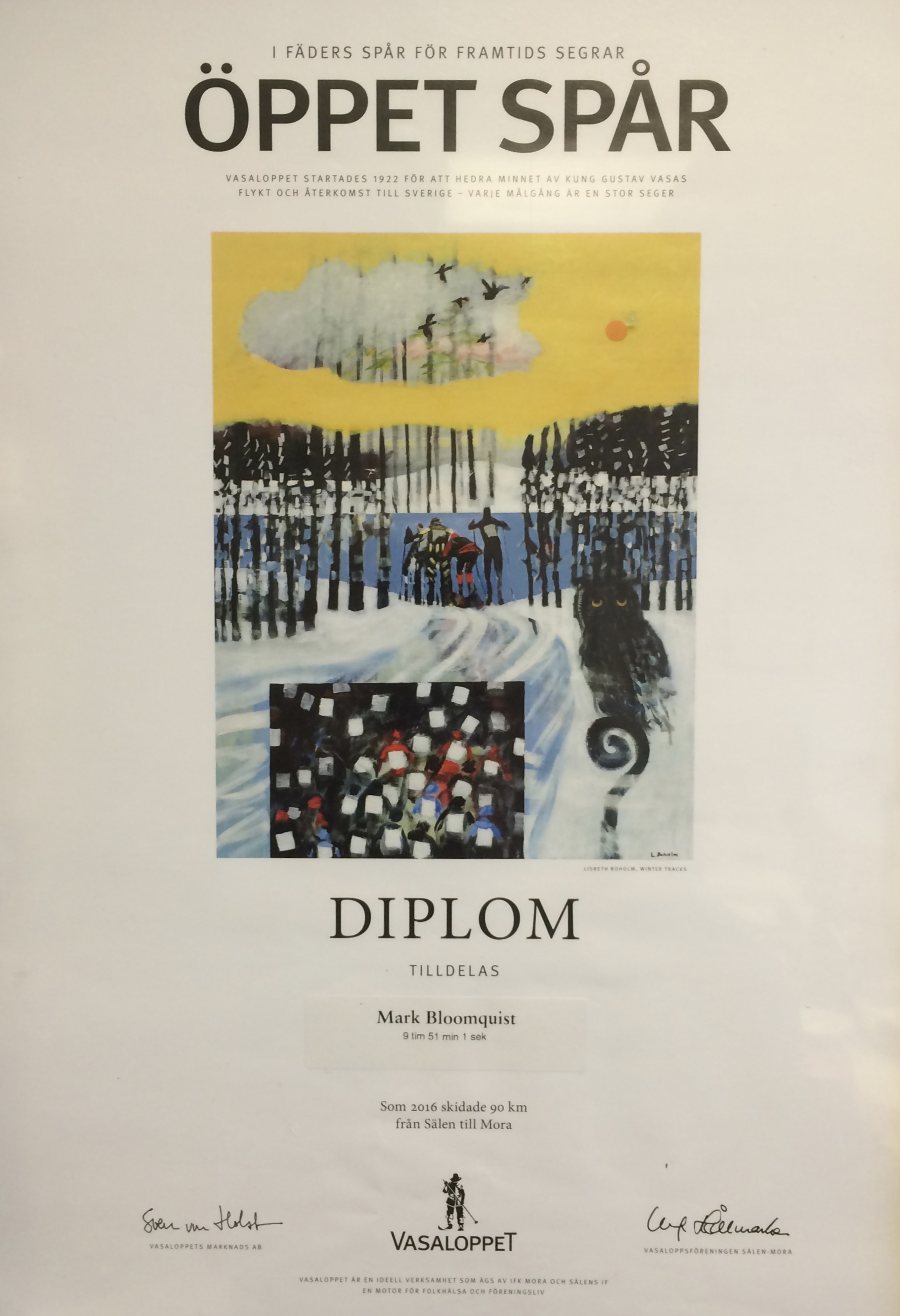 Mark Bloomquist's diplom (completion certificate) and time/progress record from the Öppet Spår event.
Mark Bloomquist's diplom (completion certificate) and time/progress record from the Öppet Spår event. -
Mark Bloomquist
-
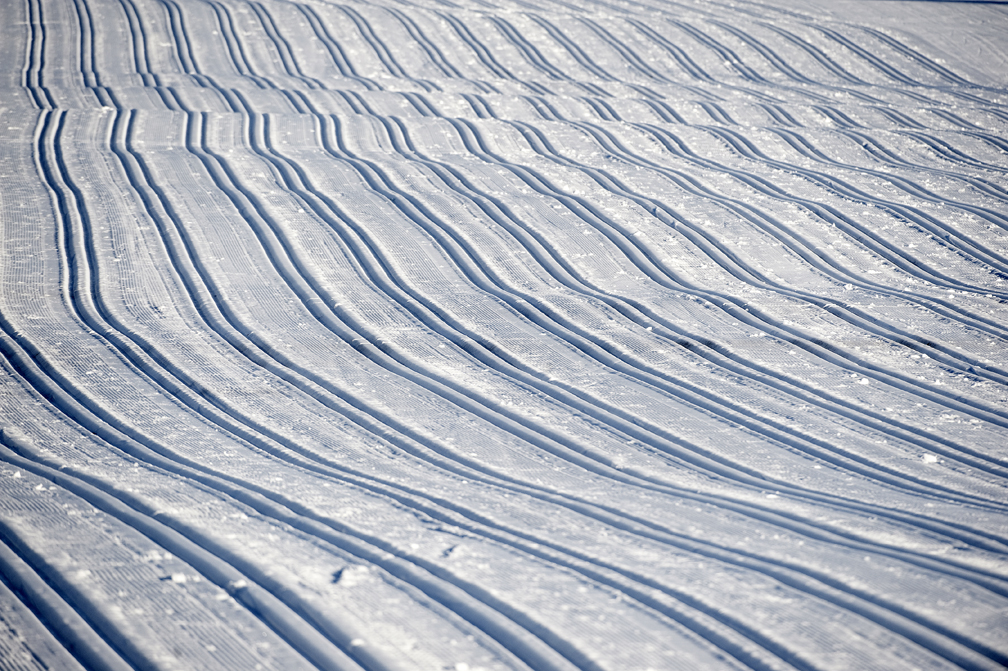 Newly made tracks at the beginning of the first hill after start. Photographed prior to the Vasaloppet race by Vasaloppet/Ulf Palm.
Newly made tracks at the beginning of the first hill after start. Photographed prior to the Vasaloppet race by Vasaloppet/Ulf Palm. -
Mark Bloomquist is a lawyer at Meagher & Geer law firm in Minnesota and is active at the American Swedish Institute (ASI) in Minneapolis. He is descended from Swedish immigrants on both sides of his family — his father’s parents emigrated from Surahammar in Vastmanland and Öjebro (near Vadstena); his mother’s grandparents came from Lindome and Bohus in the area surrounding Gothenburg. Most of his relatives remained in the old country so he and his Minnesota family have traveled regularly to Sweden to visit them, now spread into many other regions of the country.
-
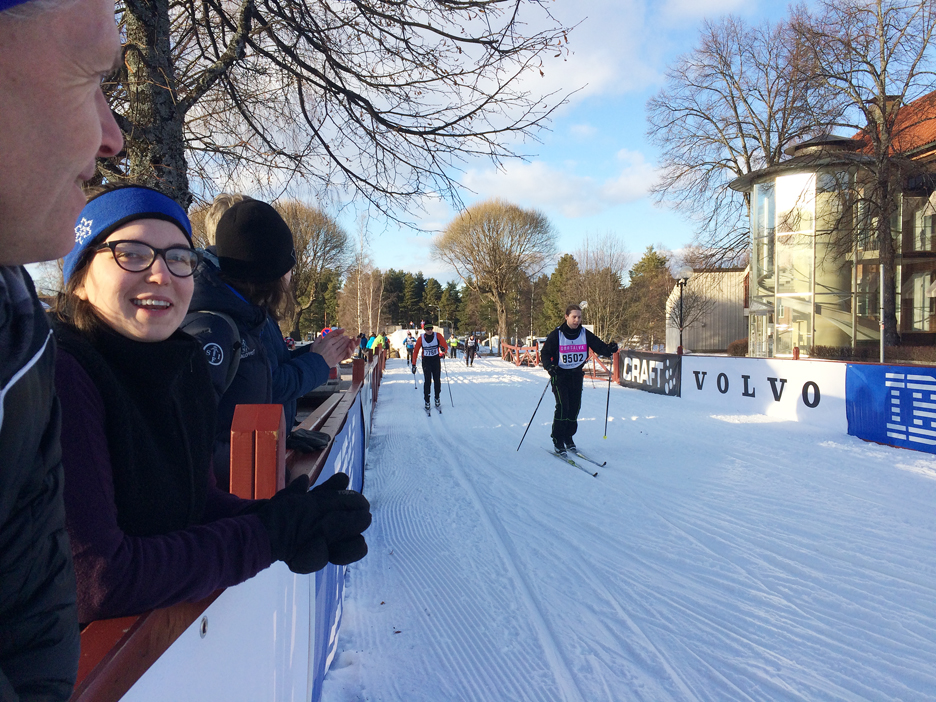 Christer Carlsson and Dana Bloomquist observing finish of a race in Mora.
Christer Carlsson and Dana Bloomquist observing finish of a race in Mora. -
-
